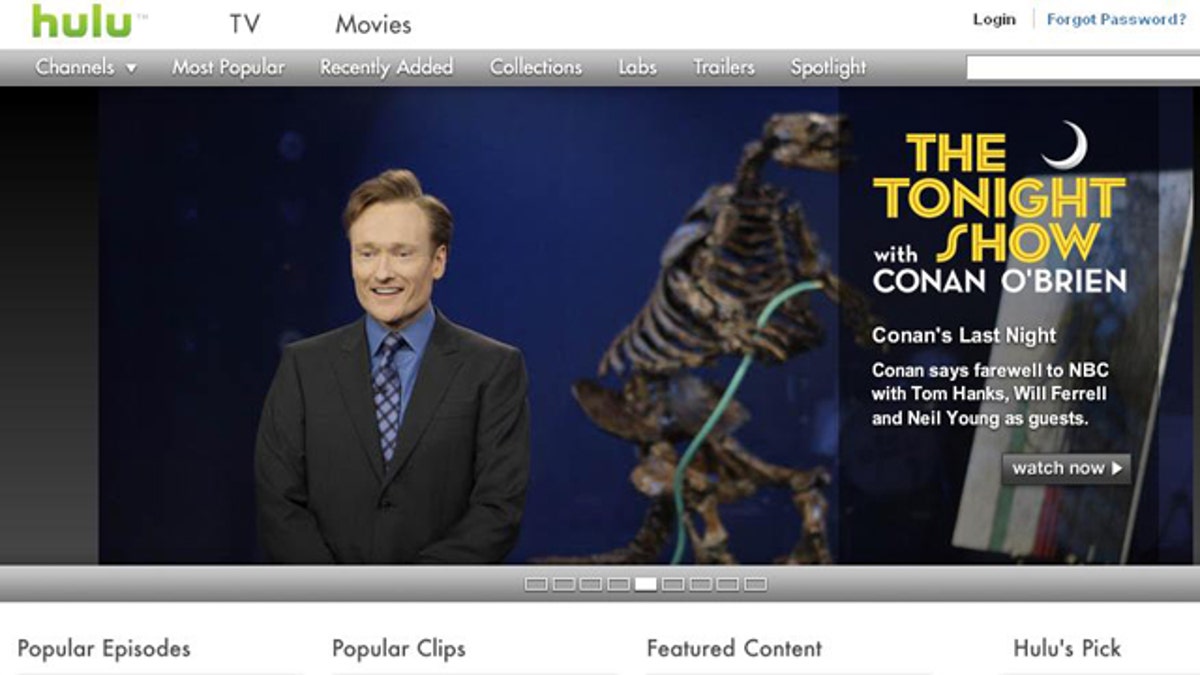
Internet TV sites like Hulu are becoming a popular way to watch TV on a PC -- and a variety of devices are making it easier to route Internet TV onto your living room set. (Hulu)
I've been doing more and more of my TV watching without actually watching a TV. It sounds weird, but it's true -- and these days, I have plenty of company.
Thanks to nifty on-demand Internet TV services such as Netflix Watch Instantly and Amazon Video on Demand -- not to mention the world-class time-waster known as YouTube -- I watch videos on my schedule. But I do it hunched over my laptop's 13-inch screen, listening to audio pumped from its tinny little speakers.
Sure, that's kind of silly, given that a 42-inch LCD HDTV with much better sound is conveniently located in my living room. That setup is a vastly more appealing venue for movies and TV than my notebook, especially when two or more people are doing the watching. It's just that while every computer is capable of playing Internet video out of the box, very few TVs have been. Most of us still own PCs that were built with cable converters, satellite dishes, DVD players, and plain old antennae in mind.
Someday soon, every TV may be Internet-ready, letting you browse and watch content from the Net as easily as you tune in cable. Quite a few models already do, including ones from Samsung, LG, Mitsubishi, Panasonic, Sony, Vizio, and other major manufacturers. The sets sport Ethernet jacks and, sometimes, built-in Wi-Fi wireless networking, so you can connect them to your home network.
Some use Yahoo's Connected TV platform, which offers both video (including Amazon and YouTube) and app-like widgets that display news, weather, photos, and more; others are compatible with Vudu, a service that specializes in renting and selling high-definition movies with particularly impressive image quality.
Of course, many of us have splurged on HDTVs within the past couple years, and aren't going to be ready to buy a new set for years to come. Fortunately, methods of getting Internet TV into a TV you already own are increasingly plentiful.
It's possible that a box that you already own -- or are contemplating buying -- is all you need to get Internet TV on your TV. If you own a Microsoft Xbox 360 or Sony PlayStation 3 gaming console, or a TiVo HD DVR, you're good to go: All three include access to Netflix's Watch Instantly library, and all let you buy and rent an array of movies and TV shows, including recent releases. Netflix is also scheduled to arrive on Nintendo's Wii this Spring.
Internet capability is also showing up as a bonus feature on Blu-Ray players, including budget-priced models such as the $129.99 Insignia NS-BRDVD3, available at Best Buy. It's enough to make the move to Blu-Ray more tempting, although I swear I'm not going to make the leap myself until I've gotten through all the unwatched DVDs salted around my house.
If none of the above devices are in your living room or likely to arrive there soon, consider buying a gadget devoted specifically to bringing the Internet to your TV. Right now, may favorite is Roku Labs' Roku HD-XR. The $130 gadget isn't much bigger than a loaded club sandwich, and it takes only a few minutes to hook up to your TV and connect to a wireless or wired network.
If you have a Netflix subscription, you can use Netflix Watch Instantly to feast on an enormous collection of movies and TV shows -- not the latest releases, but good stuff -- at no extra cost. You also get access to more recent titles for rent or purchase from Amazon Video on Demand, plus Major League Baseball, Pandora's personal radio stations, and a lot more.
Roku's principal rival at the moment is Apple's aging $229 Apple TV: It's worth considering if you're already plunking down money for movies, TV shows, and music from the iTunes Store, since anything you pay for is viewable on the Apple device as wells as PCs, Macs, iPhones, and iPods. Stiffer competition may arrive this Spring in the form of a $200 gadget based on a clever free piece of software for PCs and Macs.
Can you be a happy TV watcher with Internet TV alone? I run into more and more folks these days who tell me they've dumped cable and haven't regretted it for a millisecond. But the Net isn't (yet) a total panacea for couch potatoes.
For one thing, some significant sources of online video aren't available on any of the Net TV boxes -- most notably Hulu, the Web's dominant destinations for broadcast and cable content (and a joint venture of Fox News parent News Corp.). Many movies and TV programs haven't made the transition to the Net yet, including some you'd miss. Truly real-time programming such as news and sports is especially scarce.
Another issue: Some of the video quality of Net TV is hard on the eyeballs. A YouTube clip that's fuzzy on your notebook, for instance, only looks more rotten when it's stretched to fill an expansive HDTV. Even the high-definition shows offered by providers such as Amazon and Netflix fall short of the razor-sharp look you expect from cable, satellite, and broadcast HD. You may also find the picture jittering or stalling altogether if your wireless network has to contend with too many sources of interference.
I don't love Internet TV unreservedly, but I do have a hard time remembering life before it existed. With both Net TV and cable, my HDTV is back to being the richest source of video material in the house. And it's all just a few taps of a remote control away.
Harry McCracken blogs at Technologizer, his site about personal technology. He's also the former editor in chief of PC World. Follow him on Twitter as @harrymccracken
